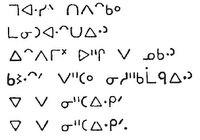Merry Xmas

This is a verse from the Bible in James Bay Cree, published in 2001 by the Canadian Bible Society. It says "Then Simon Peter answered, you are the Christ, the Son of the Living God. (of God who lives, the son.)" Matthew 16:16
The ninth word from the beginning is X for Christ. The Chi sign X is used for the name of Christ in this New Testament published in 2001. In Unicode it is U+166D : CANADIAN SYLLABICS CHI SIGN.

There is another way to write "Christ" in Cree. Here is a verse of Silent Night in Western Cree. At the beginning of the fourth line Christ’s name is written phonetically. However, ‘r’ is not a Cree sound and the syllabic used for ‘r’ shows that this is a non-Cree word. The double consonants are also foreign to Cree, so the name of Christ is identifiable as a foreign word in Cree when spelled out phonetically.
The use of the Greek letter chi for Christ has a long history. The first shorthand for Christ seems to have been ΧΡΣ P46. This site explains that the Nomina Sacra were used not as abbreviations but to set apart holy words in text.
Two kinds of shorthand were used from the third century up until the 16th century in Greek manuscripts. First, the nomina sacra, where a closed set of frequently occuring siginificant names were abbreviated to create a logographic entity. Second, there were ligatures which shortened or combined two or three letters, especially grammatical endings, later even including the accent in the ligature.
Χριστος has been represented by Χρς, or Χς, and by ΧΡ in art and other representation. I have not found the ΧΡ in manuscripts and would not expect it since the manuscript form always includes the grammatical ending.
A quick glance at some facsimiles of Greek manuscripts* shows that the words ιησους, χριστος, θεος, ανθρωπος, πατερ, ματερ, πνευμα and some other words were represented by their initial and final one or two letters which represent the grammatical ending. This could be ς,υ,ν,οι, ι &c.
For this reason, I am assuming that the transition from Χς to Χ happened with the beginning of the use of the vernacular languages in Europe, when the ending was no longer relevant. There would be no reason to retain the last letter and X alone came to represent Christ. There is also no reason to see a sign of disrespect in the transition from Χς to Χ. And so Xmas first appeared in English texts in the 16th century.
Χ retained the meaning of Christ for those who knew Greek but possibly also in some form of British shorthand at least up until the last century. It occurs in the Cree writing system devised by James Evans in 1841 and now called Canadian Aboriginal Syllabics, pictured at the beginning of this post. It is recognized that Evans drew on his knowledge of early British shorthand for the Cree syllabary. However, he must also have studied Greek so either way he would be familiar with the chi X symbol.
* Barbour, Ruth. Greek Literary Hands. 1981. Clarendon Press. Oxford.
I have previously posted on the use of the Greek chi symbol here and Greek Literary Hands here.
Update:
Further information on the Chi sign X and its first use in English are at the folloing links.
http://www.ewtn.com/library/ANSWERS/ISGODAGI.HTM
http://christmas.123holiday.net/
http://www.christmascarnivals.com/trivia/
http://www.freerepublic.com/focus/f-news/1538036/posts
This is a general hodgepodge of information but one site claims that Wycliffe used the sign X for Christ. It should be possble to check that out.

3 Comments:
and what of the Chi-Rho??
That is a more accepted shortening that simply X, certainly in the catholic faith.
Definitely the Chi-Rho symbol is a very recognizable Christ symbol. It occurs in early Chirstian art and manuscripts. Maybe next Christmas I will read up on its history. Thanks for the idea!
Ooh Tar...I thought I was gonna get shouted at!
;)
Cheers again.
Niall.
Post a Comment
<< Home